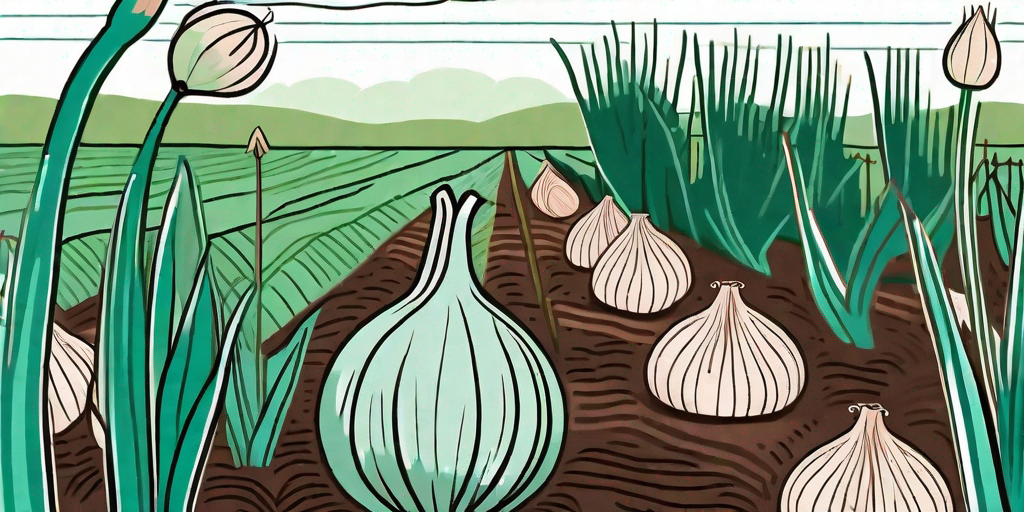
Ah, the humble shallot, the unsung hero of the culinary world. Often overshadowed by its larger cousin, the onion, the shallot brings a unique, delicate flavor to dishes that is simply unparalleled. But when is the perfect time to pluck this precious produce from your garden? Let's delve into the shallot secrets that will transform you from a gardening novice to a shallot savant.
The Shallot Lifecycle
Understanding the lifecycle of a shallot is the first step to knowing when to harvest. Shallots, like most plants, have a specific growth cycle that they follow. This cycle is influenced by various factors such as the type of shallot, the climate, and the soil conditions.
Shallots are typically planted in the fall and harvested in the summer. However, the exact timing can vary based on the specific variety of shallot and the local climate conditions. For example, some varieties of shallots are better suited to cooler climates and can be planted in early spring for a late summer or early fall harvest.
Planting
Planting shallots is a relatively straightforward process. They are typically planted as sets, which are small, immature bulbs. These sets are planted in the fall, usually in October or November, although the timing can vary based on the local climate and the specific variety of shallot.
The sets should be planted in well-drained soil, with the pointy end facing upwards. They should be spaced about 6 inches apart to allow for growth. Once planted, the sets will begin to grow roots and establish themselves in the soil.
Growth
After planting, the shallots will begin to grow. During this growth phase, the shallots will develop their bulbs and leaves. The leaves, which are green and resemble those of an onion, are an important indicator of the shallot's health and growth.
As the shallots grow, they will begin to form bulbs. These bulbs are the part of the shallot that is harvested and used in cooking. The size of the bulb can vary based on the specific variety of shallot, but most shallots will produce bulbs that are about 1 to 2 inches in diameter.
Harvesting
The final stage of the shallot lifecycle is the harvest. This is the moment you've been waiting for, the time to pluck your precious produce. But when exactly is the right time to harvest your shallots?
The best time to harvest shallots is when the leaves have turned yellow and begun to fall over. This typically occurs in the summer, usually in July or August, although the exact timing can vary based on the local climate and the specific variety of shallot.
The Art of Harvesting Shallots
Harvesting shallots is more than just yanking them out of the ground. There's a certain art to it, a finesse that can make the difference between a good harvest and a great one.
The first step in harvesting shallots is to gently loosen the soil around the bulbs with a garden fork. This makes it easier to remove the shallots without damaging them. Once the soil has been loosened, the shallots can be gently pulled from the ground.
After harvesting, the shallots should be left to dry for a few days. This allows the skins to harden and helps to preserve the shallots. Once dried, the shallots can be stored in a cool, dry place for several months.
Common Mistakes
When it comes to harvesting shallots, there are a few common mistakes that gardeners make. One of the most common mistakes is harvesting too early. If the shallots are harvested before the leaves have turned yellow and fallen over, the bulbs may not be fully developed and the flavor may not be as intense.
Another common mistake is not allowing the shallots to dry properly after harvesting. If the shallots are not properly dried, they can rot or become moldy. To avoid this, the shallots should be left to dry in a well-ventilated area for a few days before being stored.
FAQs
Can I plant shallots in the spring?
Yes, you can plant shallots in the spring, although the bulbs may not be as large as those planted in the fall. If you do decide to plant in the spring, be sure to choose a variety that is suited to spring planting.
How long do shallots take to grow?
Shallots typically take about 8 to 9 months to grow from sets. However, the exact timing can vary based on the specific variety of shallot and the local climate conditions.
Can I eat the leaves of my shallots?
Yes, the leaves of shallots are edible and can be used in the same way as green onions or chives. They have a mild, onion-like flavor and can be used fresh or cooked.
Conclusion
So there you have it, the shallot secrets revealed. With this knowledge, you're well on your way to becoming a shallot savant. Remember, the key to a successful harvest is understanding the lifecycle of the shallot and knowing when to pluck your precious produce. Happy harvesting!











